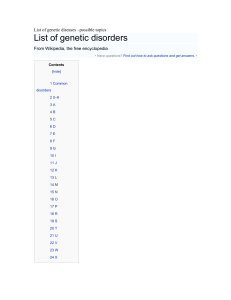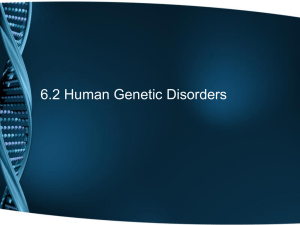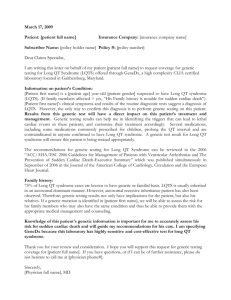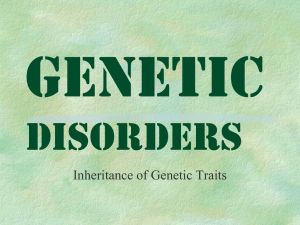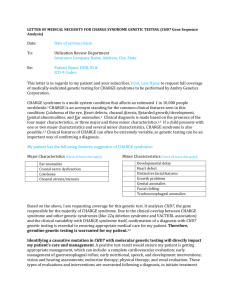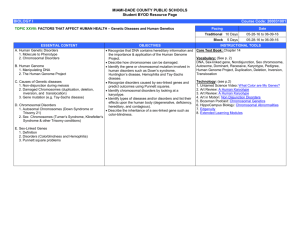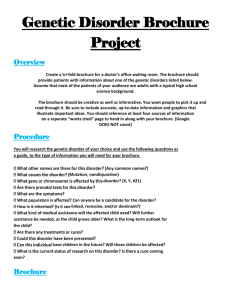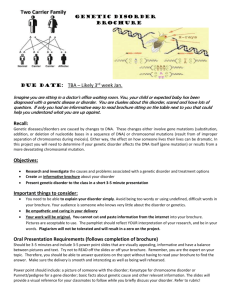IB-Bio-GeneticBrochureProject
advertisement
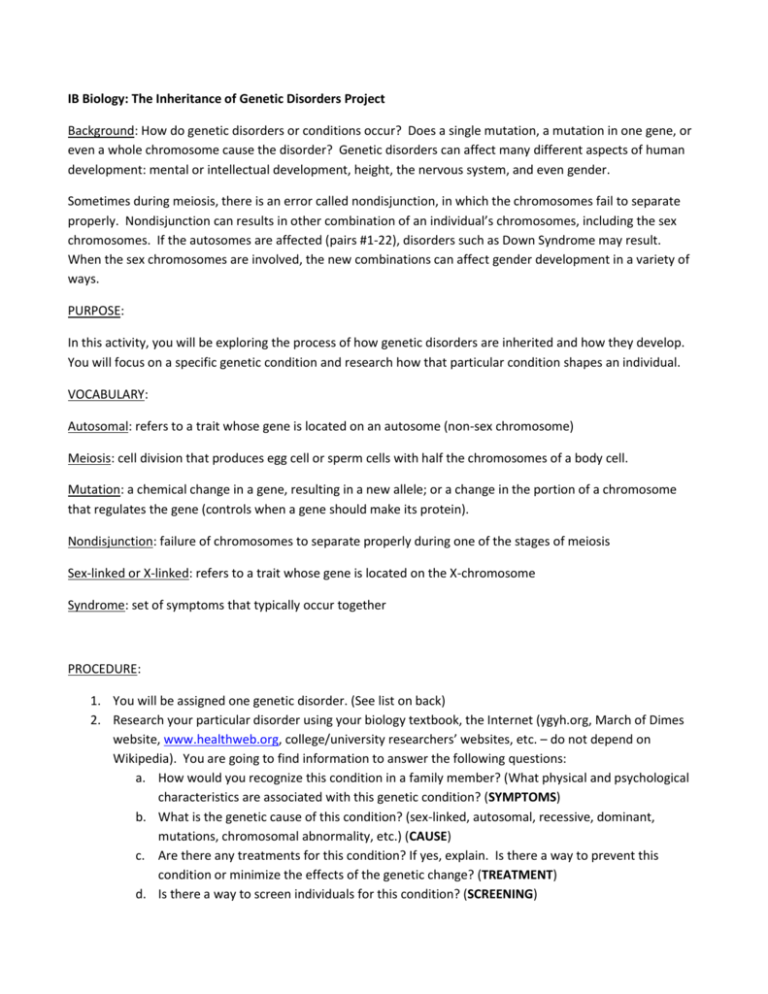
IB Biology: The Inheritance of Genetic Disorders Project Background: How do genetic disorders or conditions occur? Does a single mutation, a mutation in one gene, or even a whole chromosome cause the disorder? Genetic disorders can affect many different aspects of human development: mental or intellectual development, height, the nervous system, and even gender. Sometimes during meiosis, there is an error called nondisjunction, in which the chromosomes fail to separate properly. Nondisjunction can results in other combination of an individual’s chromosomes, including the sex chromosomes. If the autosomes are affected (pairs #1-22), disorders such as Down Syndrome may result. When the sex chromosomes are involved, the new combinations can affect gender development in a variety of ways. PURPOSE: In this activity, you will be exploring the process of how genetic disorders are inherited and how they develop. You will focus on a specific genetic condition and research how that particular condition shapes an individual. VOCABULARY: Autosomal: refers to a trait whose gene is located on an autosome (non-sex chromosome) Meiosis: cell division that produces egg cell or sperm cells with half the chromosomes of a body cell. Mutation: a chemical change in a gene, resulting in a new allele; or a change in the portion of a chromosome that regulates the gene (controls when a gene should make its protein). Nondisjunction: failure of chromosomes to separate properly during one of the stages of meiosis Sex-linked or X-linked: refers to a trait whose gene is located on the X-chromosome Syndrome: set of symptoms that typically occur together PROCEDURE: 1. You will be assigned one genetic disorder. (See list on back) 2. Research your particular disorder using your biology textbook, the Internet (ygyh.org, March of Dimes website, www.healthweb.org, college/university researchers’ websites, etc. – do not depend on Wikipedia). You are going to find information to answer the following questions: a. How would you recognize this condition in a family member? (What physical and psychological characteristics are associated with this genetic condition? (SYMPTOMS) b. What is the genetic cause of this condition? (sex-linked, autosomal, recessive, dominant, mutations, chromosomal abnormality, etc.) (CAUSE) c. Are there any treatments for this condition? If yes, explain. Is there a way to prevent this condition or minimize the effects of the genetic change? (TREATMENT) d. Is there a way to screen individuals for this condition? (SCREENING) e. What percentage of the population is thought to have this condition? Is it more common in certain populations (ethnicity, region of the world)? f. How has society interpreted these variant genetic conditions? (Are individuals with this condition accepted by society, shunned, institutionalized, teased, etc.) 3. Create a Bibliography with a minimum of 3 sources and you MUST cite sources for any pictures or diagrams that you use. 4. Use the information and pictures and diagrams you have researched to design a brochure using Microsoft Word or Publisher. In Word, click on File New and then click on the “Brochure” button. Choose a trifold brochure. 5. Make 2 copies of your brochure. One for you to turn in and one to be posted on the walls of the classroom. GRADING: Student Name: __________________________________ Genetic Condition: _____________________ Component Pts possible Symptoms 5 Genetic Cause 5 Treatment 5 Test or Screening 5 Percentage of Population 5 Societal Issues 5 Bibliography 5 Grammar/Spelling 5 Neatness/Creativitiy 5 TOTAL POINTS 45 Pts received Genetic Disorders Disorder 1. Turner’s Syndrome 2. Klinefelter’s Syndrome 3. Edwards Syndrome 4. Patau Syndrome 5. Prader-Willi Syndrome 6. Angelman Syndrome 7. Cri-du-chat 8. XYY Syndrome 9. Down Syndrome 10. Duchenne Muscular Dystrophy 11. Hemochromatosis 12. Xeroderma pigmentosum 13. Achondroplasia 14. Sickle Cell Anemia 15. Cystic Fibrosis 16. Tay Sachs Disease 17. Osteogenesis Imperfecta 18. Cockayne Syndrome 19. Phenylketonuria 20. Huntington’s Disease 21. Beta-Thalassemia 22. Marfan Syndrome 23. Neurofibromatosis 24. Gaucher disease 25. Fragile X syndrome 26. Kabuki syndrome 27. Hemophilia Student Name

